Warning: This blog post contains potentially distressing text and images.
You may not have heard of Neuengamme, near Hamburg, in the north of Germany. Established in 1938, it was built by the prisoners themselves, and had close to 90 satellite camps, known as Aussenkommandos.
This year, the theme for Holocaust Memorial Day is ‘One Day’. Looking at the records we hold relating to the Neuengamme concentration camp, I found it difficult to pick a day. I tried to pick several days, but again found it impossible and therefore didn’t do it. How do you decide what to select when every day was much the same as the one before and the one after?
My intention is not to provide a history or a catalogue of the sufferings endured in the camp. I hope, however, that I will be able to give those who have never heard of Neuengamme an idea of what was happening there, and why it gained the reputation of being ‘among the worst of the concentration camps in Germany’ (WO 309/1592).
According to the death register, at least 42,900 prisoners died in the camp. It is only an estimate. All the records were burnt by the SS, and it was bit by bit, like a monstrous jigsaw puzzle, that the enormity of what had happened in Neuengamme started to emerge.
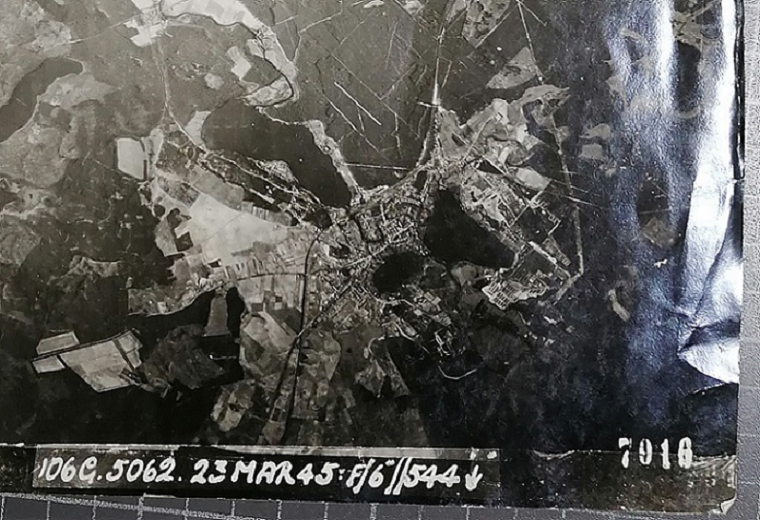
‘I was the first British (…) officer to arrive’
Sent by his commanding officer to investigate reports of a nearby prisoner camp, Lieutenant S Charlton, of the 53 Reconnaissance Regiment, arrived in Neuengamme on 5 May 1945. Several concentration camps had by then been liberated, and he must have been bracing himself for the worst. He found the camp completely empty, with a civilian policeman guarding the entrance.
The camp had machine gun posts and look out towers. He wasn’t sure whether the wiring was electrical, but it ‘looked as if it could have been’. As he was inspecting barracks, ‘two persons appeared’. These two former prisoners offered to guide him through the camp and explained the purpose of the different buildings.
‘To anybody who did not know about it,’ Charlton said of one of these buildings, ‘it appeared to be a butcher’s shop or a dairy’. It was a ‘medical experimental station’. The place appeared to have been thoroughly cleaned, and he only found ‘rubber gloves and what [he] took to be a preserved human heart in a bottle’
Charlton spent four days in Neuengamme before handing over to ‘Corps Representatives who were organising it into a PoW camp’ (WO 309/872).
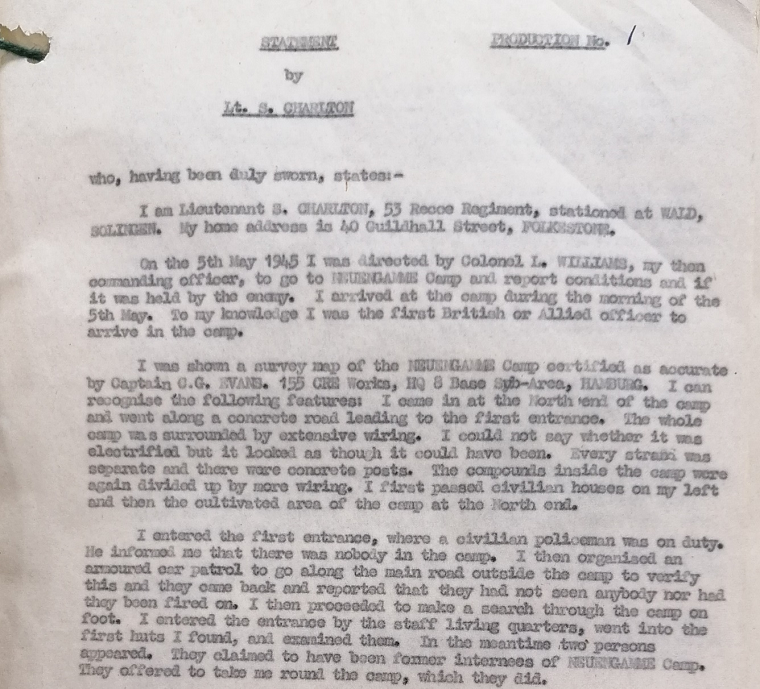
‘Extermination through labour’
The phrase ‘extermination through labour’ – ‘Vernichtung durch Arbeit’ in German – was reportedly coined by Joseph Goebbels, the Nazi propaganda minister, in 1942. On opening the trial in 1946, Major S M Stewart, one of the prosecutors, noted: ‘the phrase in its conciseness and in its form with all its horrifying implications is Dr Goebells [sic] at his best’ (WO 235/162).
At the beginning, prisoners were routinely murdered in Neuengamme. In 1942-1943, for instance, some 1,000 Russian prisoners with TB were injected with phenol, and, in the autumn of 1942, 197 were gassed with zyklon B. It all changed after the heavy losses suffered by Germany at Stalingrad. More manpower was needed to support the war effort.
From then on, Neuengamme functioned as a sort of clearing station, sending manpower to the satellite camps, and killing off those who were too weak or sick to work.
Prisoners worked 10 hours a day in inhumane conditions, and it was usually heavy work. In the Husum Aussenkommando, for instance, they dug anti-tank ditches in heavy, sodden marshland. Others worked in weapon factories, mines, shipyards, building sites or on the railways. Numerous statements describe their ‘almost complete absence of footwear’ and ‘scanty clothing’ (WO 309/872).
Paul Aage Jens Thygesen, a Danish prisoner who had arrived in Neuengamme in September 1944, worked in Husum. He kept sickness and mortality records, which he later managed to smuggle back into Neuengamme, ‘hidden in [his] rectum’. On 25 November 1944, out of 1,000 prisoners, 734 were sick, mostly with intestinal diseases (WO 309/790).
Tadeusz Kowalski, a Polish prisoner-doctor at Neuengamme, first worked as an orderly, then as a doctor in the tubercular department. He stated that prisoners mostly died of weakness. During the trial, it was noted that doctors in the camp ‘were expected to salvage those patients from whom more work could be obtained’. However, conditions in the hospital were so squalid, with three men, sometimes more, sharing a berth and all diseases put together, a blatant lack of medicines and the constant threat to be sent back to hard labour, that there was little hope of recovery. ‘The SS doctor,’ Kowalski recalled, ‘was not concerned with treatment at all. He occupied himself only with releasing patients’ (WO 235/162).
Prisoners had to work until they simply couldn’t. Then, they were sent on to other camps to be exterminated, usually Bergen-Belsen, Auschwitz or Majdanek.

‘Once, I found a dog’s tooth in a sausage’
While visiting the camp, Lieutenant Charlton came across large dumps of turnips, which seemed to have been the basis of the prisoners’ diet. Hunger was a constant torture, and many of the prisoners were too sick to eat what little food they were given.
According to statements, there were three meals a day. In 1944, breakfast consisted of 1/3-1/4 litre of ersatz coffee or thin soup and just below 110g of bread (‘1/14 loaf of bread of 1,500g’). Lunch was 1.5 litres of watery soup. Dinner was about 250g of bread, 1/3 litre ersatz coffee, 10-20g margarine, and 60g sausage or fish paste, or unpeeled potatoes – or jam, on Sundays (WO 309/1592).
Thygesen recalled: ‘once, I found a dog’s tooth in a sausage’. He said the soup was made of water and waste meat (‘udder, lungs, horse muzzle’) and turnips. Most of the time, it was only turnips (WO 309/790).
Phillip Jackson, who was 16 when he was arrested in Paris with his parents for being part of a resistance network, worked briefly in the kitchen at Neuengamme. He said they were also sometimes given noodles on Wednesdays. He also explained, during the trial, that the ‘coffee’ they were given was probably some sort of acorn-based powder.
There was a special ration for heavy workers, but at an additional 250g bread and 3g margarine, it was grossly inadequate. Along with hard labour, starvation was part of the ‘extermination through labour’ Nazi strategy to kill off prisoners without using up any additional resources.
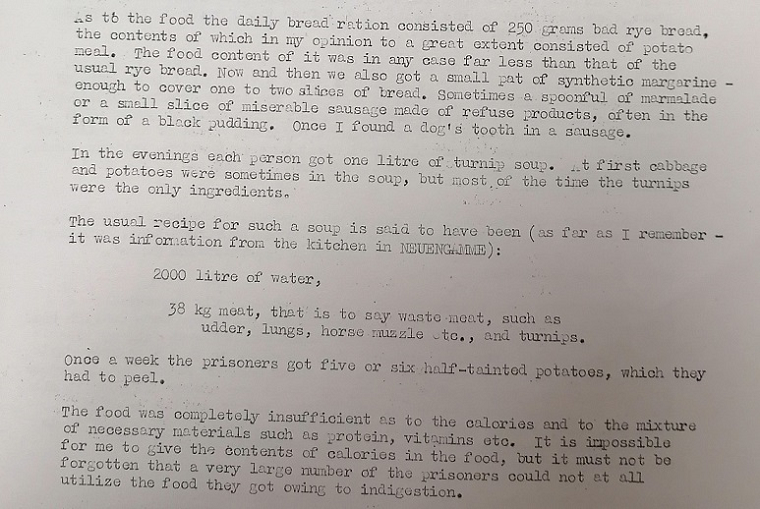
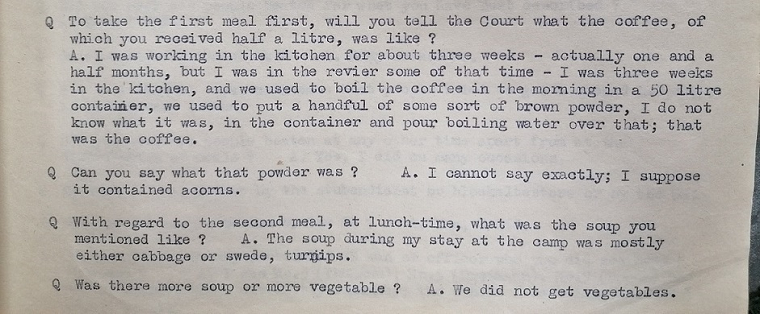
‘All the children were taken away’
Kurt Heissmeyer was an SS doctor. He wanted a professorship and, to obtain one, had to produce original research. His theory was that the injection of live tuberculosis bacilli would act as vaccination. He practiced experiments on adults in Neuengamme, then requested children.
Twenty Jewish children, ten boys and ten girls, were transferred from Auschwitz at the end of 1944. When they arrived, they were healthy, bar one, suspected of having TB. ‘They were cheerful, perfectly normal, children’.
Looked after by French doctors Prof Gabriel Florence and Dr René Quenouille and Dutch orderlies Dirk Deutekom and Anton Hölzel, the children were subjected to abject experiments in a barrack called ‘Sonderabteilung Heißmeyer’ (Heissmeyer Special Unit). Heissmeyer cut small incisions under their arms and rubbed TB in. He also used lung probes to inject the disease more deeply. Florence tried to kill off the TB bacilli by boiling them before the children were injected, but they all fell ill.
Heissmeyer had regular X-rays performed to monitor the progress of the disease, and had their armpit lymph nodes surgically removed for examination (WO 235/162).
Kowalski reported: ‘On the 18th April 1945 all the children were taken away, along with the doctors’ (WO 309/872). It was actually on 20 April that the children and their carers arrived at the Bullenhuser Damm, an old school building. The carers were hanged straight away.
Mania, Lelka, Sergio, Surcis, Riwka, Eduard, Alexander, Marek, Walter, Lea, Georges-André, Bluma, Jacqueline, Eduard, Marek, H., Roman, Eleonora, R., and Ruchla were given morphine injections by Neuengamme’s Chief Doctor, Alfred Tzrebinski, before being hanged. Johann Frahm, the Bullenhuser Damm blockleader, stated on 2 May 1946: ‘A rope was placed on their neck and, like pictures, they were hanged on hooks on the wall’ (WO 309/872).
Testifying on 3 July 1946, within the frame of a follow-up trial devoted to the Bullenhuser Damm murders, Max Pauly, the Commandant of Neuengamme, stated: ‘the 20 children were executed because they had been experimented on, and the nurses, because they had watched the experiments’. Just like the records the SS burnt before the evacuation of the camp, they were embarrassing witnesses.
Heissmeyer, in case you’re wondering, wasn’t arrested straight away. After the war, he went back to Magdeburg and was a successful TB specialist under his own name, until his atrocities finally caught up with him at the end of the 1950s. He was convicted and sentenced to life imprisonment in 1966. He died a year later.
In the words of the investigators, ‘this murder is outstanding for its utter ruthlessness and for the cold bloodiness of the accused’.
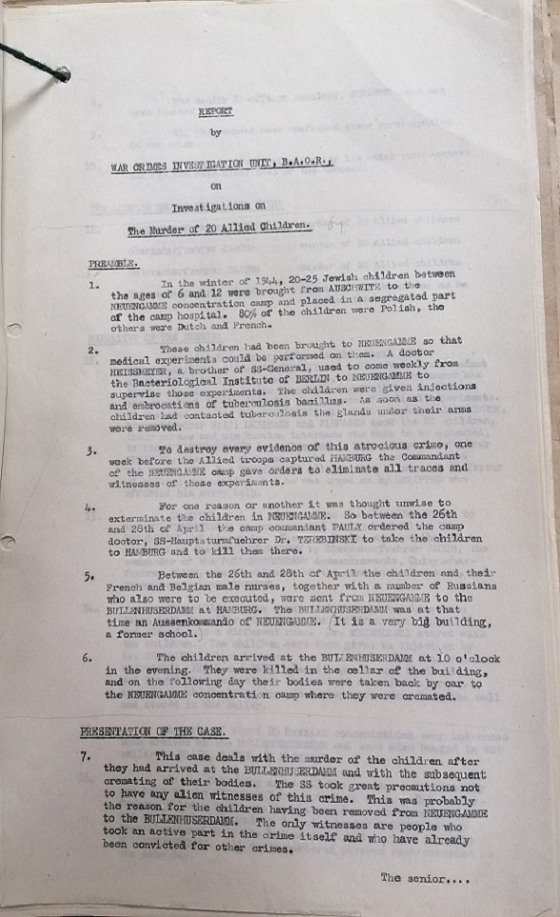
‘Each accused pleaded Not Guilty, and each was found Guilty’
The trial of 14 men who had held leading positions in the main camp at Neuengamme opened on 18 March 1946. Held at the Curio Haus in Hamburg, it lasted until 3 May. Over the next two years, 33 trials relating to Neuengamme and its satellite camps would be held, bringing 99 men and 19 women to justice.
The 14 accused were charged with committing a war crime. According to the proceedings, ‘each (…) pleaded Not Guilty and each was found Guilty’ (WO 235/659).
Giving a statement in Copenhagen on 16 March 1946, Paul Aage Jens Thygesen highlighted the
‘systematic starvation (. . .), the strong psychical pressure which constantly weighed upon the prisoners, the terrible housing conditions (. . .), hard labour (. . .) and above all: the camp leaders’ complete incompetence and lack of respect for the most elementary human necessities and conditions of life’ (WO 309/790).
Eleven of the accused were sentenced to death by hanging, the other three to long prison sentences.
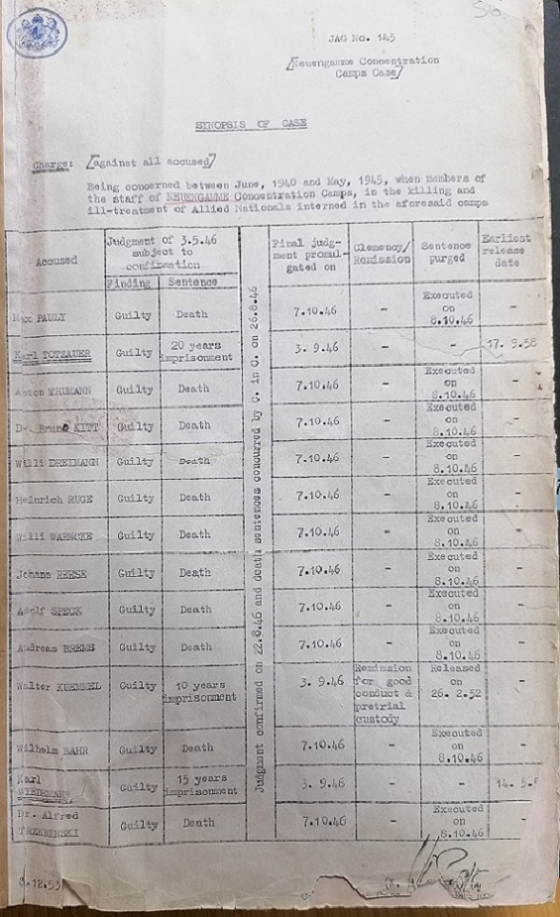
Unexpectedly I found out that a member of my own family died during the evacuation of Neuengamme and its Aussenkommandos. Today, as we remember the victims of Nazi atrocities, and like every time I think about concentration camps, I am grateful. Grateful to him, to my great-grandmother and to all the men and women who fell victim of the camp system, whether civilian or military, whatever their faith or politics. I am grateful for their sacrifice, their resilience and the constant reminder not to take humanity for granted.

Another example of what this blog does well – looking at the hidden ‘I-didnt-know-that’ corners of social history.
Man’s inhumanity to Man never fails to amaze me. That we still have genocide in this modern age is alarming since we seem to have learnt nothing from the past.
Shocking. Yes. I went to those concentration death camps when serving in British Army of the Rhine. ? ?
Auschwitz, Dachau, Bergen-Belsen, Ravensbrück, Buchenwald – all reasonably familiar names, but shocking to hear something of the widespread inhumanity in other camps – sometimes very close to large centres of civilian populations. I had no idea about Neuengamme until I started looking at registration cards for Buchenwald, on which it was sometimes mentioned under details of transfers. Let’s not forget that ethnicity, homosexuality, nationality and even poverty/worklessness were also problematic for the Nazis.
It really highlights what the free world was fighting for and most certainly must be remembered in perpetuity by all citizens of the world.
Thank you for all your efforts.
Thank you for this blog I believe it is extremely important that we continue to keep this information at the forefront of everyone’s mind. No matter how distressing this information is the reality it describes must be shared forever. On a separate note I spoke to a young beauty therapist two days ago and she told me she visited Auschwitz. I asked her why and she said she felt it was important to witness the place for herself. She is 21 years which helps you to realise that the work to ensure the next generation is fully aware does have an impact.
It is vital to read evidence such as the above in order to begin to understand what happened to innocent people of all ages in a time of War by sick individuals.
After reading such evidence over many years I cannot understand why any individual carried out such crimes against humanity.
Really disturbing that man could be so very cruel to another man, especially to helpless children who had done nothing wrong and could not do anything to help themselves. It was bad enough that they would have been taken away from family members but to be treated so inhumanely for no good reason other than another ego ……….
This subject never ceases to shock and appall – nor should it.
Thank you for this blog, we need them, this one is so sensitively presented whilst being very informative.
This article was very impressive and well done. I have added it to my own research and will discuss it with other teachers.
The files at TNA relating to Neuengamme include other tragic stories of what happened to 9000 of the inmates in the last stages of the war, which, having a family member at the camp and probably part of that disaster, I think should be recorded
Evacuations, Death Marches, and the bombings of Cap Arcona
Orders were issued for the evacuation of the main camp on April 19th. Between the 20th and 26th of April, over 9000 prisoners are taken from Neuengamme and loaded on four ships: the passenger liners Deutschland and Cap Arcona, and two large steamers, SS Thielbek and Athen. The prisoners were in the ships’ hold for several days with no food or water. Concluding that the ships contained Norway-bound fleeing Nazi officials rather than thousands of prisoners, the Royal Air Force Hawker Typhoons (RAF) bombed the Thielbek, Cap Arcona and Deutschland on May 3rd.
Intelligence that the ships carried concentration camp prisoners didn’t reach the squadrons in time to halt the attack. Survivors who jumped into the water were strafed by cannon fire from the RAF aircraft or shot by Nazi officials.
Thousands of dead were washed ashore just as the British Army was successful in occupying the area on land. The British forced German POWs and civilians to dig mass graves for the dead. Approximately 7,100 prisoners and officials died in the raid; only 450 prisoners survived
600-700 concentration camp prisoners remained in the main camp under SS orders to destroy all incriminating documentation, dismantle many areas of the camp, and tidy the site. On 2 May 1945, the SS and the last of the prisoners left the Neuengamme concentration camp. The first British soldiers arrived the next day and, seeing a barren and clean site, report the concentration camp as “empty”
TNA Catalogue description
Neustadt Bay, Germany: death of allied nationals on board ship and investigations into…
Reference:
WO 309/1592
Description:
Neustadt Bay, Germany: death of allied nationals on board ship and investigations into conditions at Neuengamme Concentration Camp, Germany
Date:
1945 May-1946 Feb
Held by:
The National Archives, Kew
Former reference in its original department:
War Crimes Investigation Teams(WCIT)/2/C/4
Legal status:
I have been studying war atrocities, especially the Holocaust (HaShoah) for over fifty years and I am still disturbed by such horror.
I thank the author of this blog for providing the research.
A truly evocative picture of the nature of human subjugation
I have not heard of this place. Thank you for bringing out into the open. No doubt there are quite a number of other camps we have not heard about. I have just finished reading about the first transport of Jewish girls to Auschwitz, and that was pretty harrowing. They also had to build their own camp, and were treated just as appalingly. I salute the survivours.
I had heard of all the other concentration camps except this one in Germany.This in itself was quite unusual. Because so as not to alert the German population as to the Nazi’s No 1 secret priority programme of extermination most were located in other countries over their borders.
Other camps also had medical experiments going,Herr Dokter Mengele was a well known killer.Somehow he escaped the gallows at the Nurenburg trials-and lived happily ever after.I doubt if his conscious ever pricked him the rest of his life.
But without doubt that great Neuengamme propaganda slogan ‘Death Through Hard Work’ (forget the sickness and starvation) makes the other ‘Arbeit Machs Frei’ Work for Freedom-sound almost friendly.
Life was Hell on earth for all those prisoners,mainly Jewish,I can only hope that all their souls found eternal peace,Amen
Still manages to shock,as it rightly should.Such inhumanity.
I only found out about 5 years before my mum passed away. So about 17 years ago. That 1 of my relatives was murdered in the gas Chambers in Auschwitz. I never knew about this place. The fact that Women were involved in what went on at this camp
Is Quite disturbing to read. But I thank you for posting this. I had heard that there is a plaque in memory of my relative. In the Synagogue in Liverpool I hope to be able to see this for myself one day. Those were the darkest days in living memory
They must Never be forgotten and Never Ever be Repeated .
I only remember as a child Blackout curtains, searchlights in the distance over and around Liverpool, and later prisoners of war attempting to unearth unexploded bombs in nearby fields,however reading this well researched blog again reminds us all of suffering on so many during the ww2 conflict.The true story of all that happened to the Jews and others continues to be uncovered and will help this generation and those that follow, the full depth of what the Nazi war machine was intent on inflicting the world at large.
I constantly wonder how humans can be so cruel to one another….all in the name of power, greed and unfounded biased hatred! Perhaps that is what is meant by “original sin”, which doesn’t go away for some! I know of no other species of animal that would behave like that!
Extraordinary barbarity visited on decent, ordinary people.
One’s imagination just can’t even guess at the awfulness of what happened.
Blogs like this are important, if harrowing to read, to ensure we NEVER forget.
We can never forget these appalling acts. So appalling one cannot comprehend man’s inhumanity. It must never happen again. We all have a duty to call out acts of hate and intolerance.
Thank you. I have read many books on the Holocaust but had never heard of Neuengamme. The history of the Holocaust never ceases to shock me. We must all shout loud and clear against the brutality that is still occurring all over the world.
A truly harrowing read. I had visited Auschwitz 11- Birkenau in the past and was appalled and shocked by the prisoner conditions and treatment. I was born in 1943 and to see how children of my age being led to the gas chambers brought years to my eyes !
Oh god. No matter how much I read it still horrifies me what humans can do to each other, They never learn. We still see again in the horrors of even more modern wars. I feel sick at what they do.
Say their name … never forget.
Thank God we won the War, both 1st and 2nd otherwise these atrocities would have continued here and elsewhere. God bless the Jews and others who suffered and died, may they Rest in Peace
I heard of this camp through the programme where Nazi murderers of the camps were hunted down. I couldn’t read some of this blog it was too upsetting.. It’s beyond understanding how human beings could do anything so abominable to another human being. I hope that when the perpetrators were caught and waiting for the sentences to be carried out that they took time to reflect on their past and the crimes they so blatantly committed …
For those who wish to learn more, a search on IWM’s Collections website shows a number of oral histories relating to Neuengamme Camp (enter ‘German Concentration Camp, Neuengamme, Germany’ on the search page at https://www.iwm.org.uk/collections).
Please be aware that these interviews and recollections may cause distress.
In addition IWM also holds a number of post-liberation images and other artefacts relating to the camp and its satellite. These can be found by going to the IWM Collections page (https://www.iwm.org.uk/collections) and entering ‘Neuengamme’ as the search term.
Such brutality shocked to know about this con camp hope such horror will never happen again
I have just finished reading “The Nine” by Gwen Strauss. Neuengamme was mentioned briefly. I had never heard of this camp. The book is the story of nine women, seven French and two Dutch who had all worked with-the French Resistance and who were captured, tortured in Paris, and sent to Ravensbruck. From there they were sent to work in a HASAG munitions factory at Leipzeig. As the Russians and Americans approached from opposite directions, they were sent on a death march, but decided to escape. They were successful and made their way eventually to the Americans at Colditz. It is an amazing testamony of human will to survive. I can highly recommend this book.
My uncle, Alphonse Alboort, died in Neuengamme in march 45. He was 19. Neither my mother or my gradmother wanted to talk about him. So I am grateful for any information I can get. And so are my siblings.
I lost 3 family members during the war and 2 were badly injured. Their lives went to save us all from such atrocities suffered by the Jews and others. Such a terrible camp. God bless those that died, may they rest in peace.
Such unbelievable inhumanity. Makes you wonder at the mentality of these monsters- to carry out such revolting experiments on CHILDREN! When I think of my own grand-daughter and the way I just want to hug her, envelop her in love and security- the vision of what those poor children must have undergone is absolutely heart-breaking.
My Great grandfather was deported at Neuegamme from June 1944 , as “Prominenten” (Personnality-hostage). After D-Day, Germans arrested a lot of French people as these hostage, to get trade-off means. They were in special barracks, separated from the others and not obliged to work.
A swedish officer of the red cross helped them after negociation with the Germans.
They were evacuated from the camp before the arrival of the British troops and ended their travel near Pilsen ( Cz). Thanks to NA to have highlighted this unknown KZ camp..
My uncle Arnold died in this concentration camp in March 1945 aged 21. He had gone to another town to find food and when the Germans rounded up all the men was told that he didn’t need to go as he was only a visitor. My father came to live in England after the war and would be very emotional when speaking of his brother. I felt sick with horror at reading above – ‘The phrase ‘extermination through labour’ – ‘Vernichtung durch Arbeit’ in German – was reportedly coined by Joseph Goebbels, the Nazi propaganda minister, in 1942.’ – as this is how I was told by my father that his brother died. It’s only after finding his name on another website that I now know where he died.
How even to comment on such tragic events? It defies even the blackest imagination, yet it happened. I salute the innocent dead, may their memory live forever – thank you for the posting, do continue the research and publish the findings, that is one way to keep those victims alive. Thank you.
During the whole of the nineties I lived in Hamburg and with my then German boyfriend, visited Neuengamme.
I saw the sites like that heavily raised steep concrete incline in which the prisoners had to push metal carts laden with clay to the factory above.
I also saw the then one memorial that just informed me that this camp murdered not just Jews, but many people from all countries including Germany.
I had heard of all the other infamous camps like Belsen and Auschwitz, but never before Neuengamme. I walked around searching for more information but then just came upon a modern German prison. Later, I came across a rail track that included one of those notorious cattle trucks for transporting prisoners.
Nobody else was visiting the site but we came upon an elderly gentleman who claimed he was a young child living in one of the many houses opposite the camp during that time.
Translated by my then German boyfriend, he began to say that Neuengamme will soon become a memorial site. In which now gladly I believe is the case.
The old guy told us that the prisoners were helping to build brick-blocks for German barracks and that they also had to dig out a route from the camp along the Elbe to Hamburg for transportation.
He told us both about the evacuation of the camp in which many died aboard ship bombed by the RAF.
There is a straight road that many homes faced opposite the camp. The guy even pointed out the camp commandant’s house that were adjacent to those homes.
He told us than whenever a fresh transport was arriving, the local residents had to shut their curtains and not ask questions.
To me, he knew enough about it to tell all today – so they must have all known about it back then!
Keep the memory of Neuengamme going today as with all other past Nazi atrocities.
Christine Peters
This is a kind of PS as it refers to after the War.
My uncle Lt Col Robert Appleby MBE was the Commandant of Neuengamme camp after the War. It was used as an internment camp/prison for ex Nazis and war criminals. I have a letter of thanks written by a German. In it, besides inviting Bobby to come and stay with his family, he says “All members of your staff and the internees who knew you remembered very often the time with you and regretted your leaving. They are still of the opinion that with you, Col. Appleby, left the Gentleman. I should also like to use this opportunity to tell you how very much we all appreciated the way you treated us and that we shall never forget our Col. Appleby.” Apparently Uncle Bobby’s leaving present to them were pairs of socks which he had managed to acquire, for which they were most grateful.
My uncle hated the Germans, having fought against them in two World Wars. However it is good to know that he earned the respect and thanks of the German prisoners.
My grandfather died in Neuengamme mid November 44, he was brought there early October 44 from the Netherlands (Putten razzia, 1/2 October, see https://www.oktober44.nl/). He survived less then 6 weeks digging anti-tank ditches as described above.
Dramatic for its victims, the impact of such events is felt through generations of uncountable families and is not to be underestimated. The same avoidable dramas continue to unfold today to satisfy the ego of autocratic “leaders”.
My grandfather was in the British Army. Piecing together some stories he told our family, he was in an early type of special forces unit. He told me about how he was one of the first soldiers to get to Neumgamme and that they liberated it. I believe him, although it states historically that the camp was empty. He had nightmares and became an alcoholic on his return to Scotland. I only started looking into his military history recently and am so sorry that he had to witness all the things he did. I also desperately hope humans never do these atrocities to other humans again. I’m sorry that people did this to other people.
My grandfather from my father’s side, Dirk van de Gevel, died in an outpost of Neuengamme on 23 November 1944. He did something in the resistance, I don’t know what. German soldiers took him from his home in Haarlem, the Netherlands, on 23 August 1944. He was first transported to the Amersfoort camp and then to Neuengamme.
When he was taken from his home, my father, who was 11 at the time, was there and couldn’t do anything about it. He and his mother only heard years after the war what had happened. It traumatized my dad for life.
Thank you for writing the blog. I knew the camp was very awful, but I didn’t know about the medical experiments.
Thank you so much for publishing this piece about this little-known camp.
I am writing a book about this camp and also about the tragic S.S. St. Louis.
Future generations must know about these places, the events, and what took place.
We must keep telling the stories and pray people never forget.
Your research is extremely helpful.
In early May 1945, the Royal Artillery unit my Dad was in took over the management of Neuengamme. He never named the camp but described where he was. It was that place. On one occasion, he was put in command of sentry duty due to a shortage of NCO’s. He was briefed by his CO to tell the inmates, mainly Russian and Polish slave labourers, not to leave to camp at night to forage for food as there was a risk they would be shot by patrolling MP’s. One of the Guard insisted he knew who was responsible. In spite of the other sentries telling the soldier this couldn’t be true, he singled out one of the inmates and shot him in the leg to prevent him leaving the camp. Medical attention was given to the inmate and the offending soldier was taken away by MP’s and was never seen again.